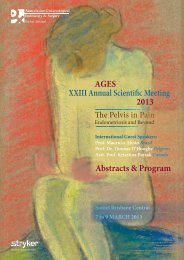You also want an ePaper? Increase the reach of your titles
YUMPU automatically turns print PDFs into web optimized ePapers that Google loves.
18<strong>ABSTRACT</strong>S continuedFRIDAY 21 NOVEMBER 2008randomized control trial compared sacral hysteropexyand vaginal hysterectomy and repair10 reported asignificantly higher re-operation rate for prolapse in thehysteropexy group at 2 and 5years.The literature demonstrates that the vaginal approach issuperior to abdominal approach in the management ofuterovaginal prolapse in those requesting uterinepreservation.References:1 Maher CF, Cary MP, Slack MC, Murray CJ, Milligan M,Schluter P. Uterine preservation or hysterectomy atsacrospinous colpopexy for uterovaginal prolapse? IntUrogynecol J Pelvic Floor Dysfunct 2001;12(6):381-4.2 Hefni M, El Toukhy T, Bhaumik J, Katsimanis E.Sacrospinous cervicocolpopexy with uterineconservation for uterovaginal prolapse in elderlywomen: an evolving concept. Am J Obstet Gynecol2003;188(3):645-50.3 Kovac SR, Cruikshank SH. Successful pregnancies andvaginal deliveries after sacrospinous uterosacralfixation in five of nineteen patients. Am J ObstetGynecol 1993;168(6 Pt 1):1778-83.4 Hiltunen R, Nieminen K, Takala T, et al. Low-weightpolypropylene mesh for anterior vaginal wall prolapse:a randomized controlled trial. Obstetrics AndGynecology 2007;110(2 Pt 2):455-462.5 Nguyen JN, Burchette RJ. Outcome after anteriorvaginal prolapse repair: a randomized controlled trial.Obstet Gynecol 2008;111(4):891-8.6 Sivaslioglu A, Unlubilgen E, Dolen I. A randomisedcomparison of polypropelene mesh surgery with sitespecificsurgery in treatment of cystocele.International Urogynecology Journal And Pelvic FloorDysfunction 2007;published online(DOI 10.1007/s00192-007-0465-y).7 Belot F, Collinet P, Debodinance P, Ha Duc E, Lucot JP,Cosson M. [Risk factors for prosthesis exposure intreatment of genital prolapse via the vaginalapproach]. Gynécologie, Obstétrique & Fertilité2005;33(12):970-974.8 Leron E, Stanton SL. Sacrohysteropexy with syntheticmesh for the management of uterovaginal prolapse.BJOG 2001;108(6):629-33.9 Barranger E, Fritel X, Pigne A. Abdominalsacrohysteropexy in young women with uterovaginalprolapse: long-term follow-up. Am J Obstet Gynecol2003;189(5):1245-50.10 Roovers JP, van der Vaart CH, van der Bom JG, vanLeeuwen JH, Scholten PC, Heintz AP. A randomisedcontrolled trial comparing abdominal and vaginalprolapse surgery: effects on urogenital function. BJOG2004;111(1):50-6.Author Affiliation: Associate Professor ChristopherMaher, Brisbane, Qld, Australia.LAPAROSCOPIC APPROACH TO UTERINE PRESERVINGPROLAPSE SURGERYFriday 21 November / Session 10 / 1450-1510Lam ATraditional approach to significant utero-vaginal prolapse,defined as ≥ stage 2 POP-Q prolapse, often involvesvaginal hysterectomy and vaginal repair. Increasinglymore and more women are interested in uterinepreservingprolapse surgery. The variety of reasons whichmay influence women in seeking this line of surgicalmanagement includes:• Fertility-preserving option – nulliparous or multiparouswomen• Fear of loss of femininity• Cultural factor• Psychological factor• Potential de-novo bladder or bowel dysfunction• Potential impact on sexual function• Anatomical considerations – loss of vaginal length,loss of central support leading to possible subsequentvault prolapse• Morbidity associated with hysterectomy• Hysterectomy may not necessarily reduce the risk oflong-term prolapse recurrenceAnatomical considerations: Uterine prolapse occurs as aresult of damage to Delancey level I support ie theutero-sacral cardinal complex.Uterine prolapse may occur in isolation or as part of amulti-level, multi-compartment pelvic floor damage.Uterine prolapse may therefore occur along with level IIanterior and /or posterior compartment defects, and levelIII defects.Women who have uterine prolapse may also havecervical elongation which can result in the leading edgeof the prolapse, namely the cervix (point C of POP-Q)presenting outside while vaginal posterior fornix (point D)remaining above the hymenal remant.Management options: Frequently, most women withsignificant utero-vaginal prolapse are advisedOvum II by Ana Duncan
















